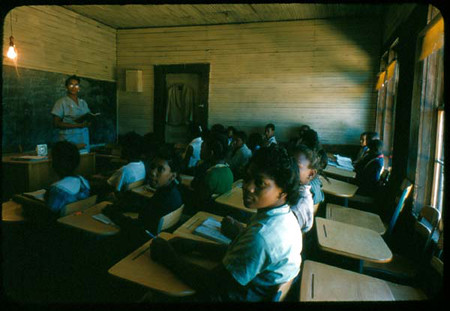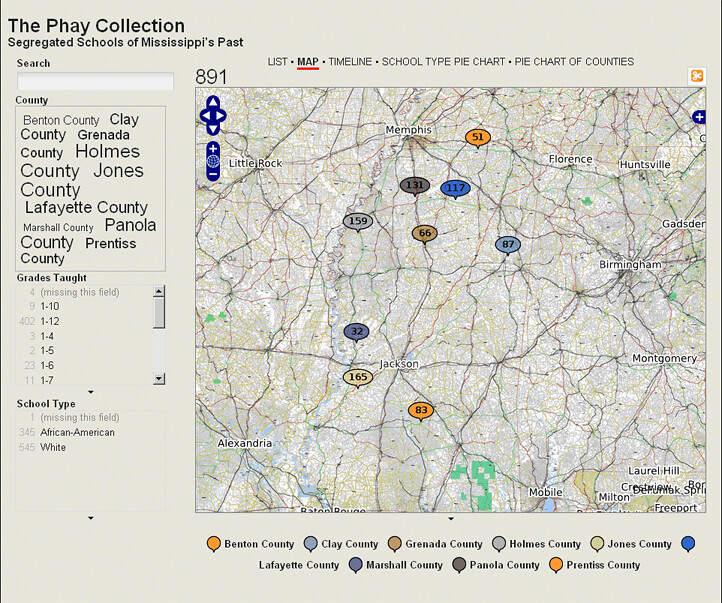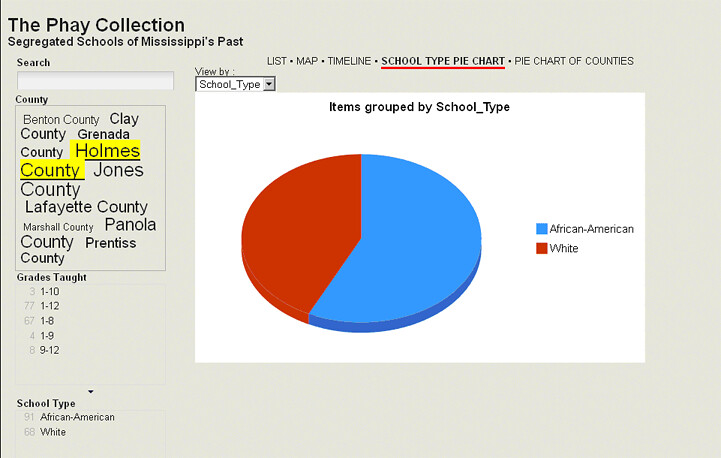Phay User Story
How Gloria Uses Viewshare: Exploring and Sharing Community History Through Interface Design
The National Digital Information Infrastructure and Preservation Program at the Library of Congress was pleased to have Gloria Gonzalez as a junior fellow this summer at the Library of Congress. After graduating with a BA in philosophy and religious studies from the University of Mississippi, Gloria spent her summer at the Library of Congress before beginning her studies in UCLA’s MLIS program. Over ten weeks she worked on a series of projects, but she was particularly enthusiastic about the way she was able to use Viewshare, the free and open source tool we are working on, to help tell a story about a collection of historic photographs she had worked with back at the University of Mississippi.
After a short demonstration of the Viewshare tool I asked her if she had any ideas for collections that might benefit from Viewshare. She suggested that she might be able to use it with the University of Mississippi’s John Elon Phay Collection. The Phay Collection is a set of photographs and slides containing images of the segregated Mississippi public school system from the 1940s and 1950s. Here is what she had to say about the collection in an email. “I care about this collection DEEPLY; I worked around 600 hours over the last year scanning the photos and slides while making an Excel sheet of the metadata at the same time.” Gloria had spent the last year scanning this collection; she knew it very well, and like many aspiring and professional archivists, librarians, and curators across the country, she cared about the stories that each of the photographs in this collection, and what the collection as a whole tells about her community. Through her hard work, and the resources of the University of Mississippi’s archives, the entirety of this collection is now available online.
The photos in the collection document personal and local stories, but they also are part of an important national story. For example, take a look at this 1955 image of a classroom of 5th graders from the Tchula School in Holmes County Mississippi.

Holmes County - Tchula School - 5th Grade Classroom - 1955
What Viewshare Does for Gloria and Ole Miss
Gloria and the staff she worked with at the University of Mississippi know a lot about archives. They know a lot about this and their other collections, and they have the technical skills and abilities to get these collections online and accessible. What Viewshare is letting Gloria and the University of Mississippi do is provide another mode of access to this collection. Pamela Williamson, Curator of Visual Collections at the University of Mississippi, and director of the digitization of the Phay Collection explained how the Viewshare views supplement the existing online collection. “[Viewshare] really picks up where our digital collection management system leaves off. It allows the information presented by the collection to be seen and manipulated in a way that builds and expands our online Phay Collection.” The central idea here is that the stewards of these collections, librarians, curators, archivists and historians, have a ton of knowledge about them, and if we can just build a tool that can make it as easy as possible for them to create dynamic and engaging interfaces to those materials we will have done a distinct service to anyone interested in understanding and exploring the history of the nation. Williamson agrees on this point by adding, “the interactive element of the Viewshare views is quite engaging. The interfaces that Viewshare creates allows patrons to get a better understanding of the collection by illustrating relationships between the items, like the spatial relation of the counties pictured in the map view and the dates of the items pictured on the timeline.”
In short, Gloria and the archivists and librarians she worked with on this collection have extensive and invaluable expertise with this collection, but what they don’t have is an expansive web development staff to build and design interfaces to this content. The result is that this collection, like so many collections of cultural heritage materials, is now accessible online but not in the rich and interactive ways that Gloria and the staff at the University of Mississippi might like.
The idea behind Viewshare is that by building a common, easy-to-use, open source and extensible web application, and providing the training and documentation to make sure that it is used, the Library of Congress can help support stewards of cultural heritage collections across the country. Specifically, by empowering archivists, curators and historians around the country to create interfaces to the collections they know so well, and in so doing help them serve their missions to act as sites of public memory in the communities they serve.
The idea behind Viewshare is that by building a common, easy-to-use, open source and extensible web application, and providing the training and documentation to make sure that it is used, the Library of Congress can help support stewards of cultural heritage collections across the country. Specifically, by empowering archivists, curators and historians around the country to create interfaces to the collections they know so well, and in so doing help them serve their missions to act as sites of public memory in the communities they serve.
Gloria’s View of the Phay Collection
Gloria had extensive first hand knowledge of the Phay collection, she had in fact scanned all the images and entered all of their data, but working with Viewshare to create an interface prompted her to think about the collection in the aggregate, to think about it as a corpus instead of thinking of it as a set of records.
While reflecting on her experience with the Viewshare platform, Gloria said, “Using [Viewshare] taught me that creating an interface is an exploratory and interpretive act. Equally interesting is the fact that the resulting interfaces that are possible with [Viewshare] invite exploration and interpretation of the collections they present. Making views that users can manipulate to gather the information they need was really fun, and they’re a great addition to the existing online collection.”
Much of what Gloria learned about the collection is now on display in the interface to the collection she created. The interface she created invites the same kind of exploration and interpretation while still suggesting some of the ways that she felt were the most important was of seeing the collection. The following screenshots walk through some of examples of the view Gloria created and the way these views suggest exploring the collection from distinct perspectives.
Phay Collection Map View
This map view draws attention to the geographic distribution of the photographs across the state. It also shows the frequency of the number of photographs taken in each county. In this sense, the view provides both a way to navigate this collection, and broader perspective of the collection as a whole. Further, clicking any of the facets on the left allows us to see how the various grade levels and school types are represented geographically in the collection.

Phay Collection Timeline View
The Timeline presents the photos as part of the chronology of photographer John Phay’s work. It is all too easy to interpret this kind of collection as a static set of documentary evidence of these schools. However, a chronological interface to the collection that suggests considering the way the photographer’s approach to documenting the schools developed over time. It reminds users that while the photos do document a historical moment they are also the compositions of an individual.

Phay Collection Chart View
The chart views, like this school type chart, allow us to see the distribution of the photographs of African-American and White schools in each county and by each grade taught. These views let us understand more about the composition of the collection of photographs, and the communities the photographs document. Importantly, like many archival collections, the coherence of this collection is of critical importance. The collection as a whole was created as part of surveys performed in the mid-1950s by the Bureau of Educational Research at the University of Mississippi. To this extent, the collection of photographs is also a collection of survey data collected by the Bureau of Educational Research. This interface exposes and focuses attention on how the aggregate information of the collection is in fact a historical data set.
Embedding the Interface
Within the next few months the University of Mississippi library staff intends to embed this interface, Gloria’s interface, to the Phay collection in their own website. Much like Youtube allows anyone to take the videos they have put on the site and embed them in there own sites Viewshare allows users to take the interfaces they create and embed them in their own sites. Unlike Youtube, Viewshare’s interfaces are entirely made up of HTML and javascript, which means that they can be styled to seamlessly fit into the canvas of the University of Mississippi’s collections site.
Soon, anyone who visits the University of Mississippi website for this collection will be able to navigate and explore through each of the interfaces and facets Gloria assembled. This interface helps showcase the collection and the hard work that went into organizing and putting it online.
The interface invites anyone visiting the site to engage in deeper exploration and understanding of the collection. Further, every time someone loads this interface, or any of the interfaces Viewshare enables, it represents a concrete way in which the time and energy the Library of Congress and Zepheria have invested in building this platform. This story illustrates the kind of direct role the Library of Congress can play in helping the stewards of American history, the librarians, archivists, historians, and curators, to engage their communities to explore their and understand their history.
The interface invites anyone visiting the site to engage in deeper exploration and understanding of the collection. Further, every time someone loads this interface, or any of the interfaces Viewshare enables, it represents a concrete way in which the time and energy the Library of Congress and Zepheria have invested in building this platform. This story illustrates the kind of direct role the Library of Congress can play in helping the stewards of American history, the librarians, archivists, historians, and curators, to engage their communities to explore their and understand their history.
